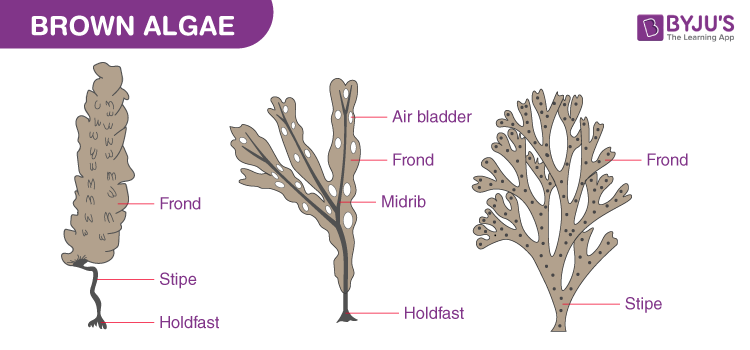Brown algae are a group of algae belonging to class Phaeophyceae. They are named due to their colour, which varies from brown to olive green. They are mostly found in marine environments. There are around 1500 species of brown algae, which vary greatly in their size and shape. They are multicellular and the colour depends on the ratio of chlorophyll and the pigment, fucoxanthin. They contain seaweeds, some of the notable examples are Ectocarpus, Fucus, giant kelps, Sargassum, etc.
Download Complete Chapter Notes of Plant Kingdom
Download Now
General Characteristics of Brown Algae
Habitat- Brown algae are mostly marine. They are found in cold waters along the coast. They are either free-floating or found attached to the substratum. Ectocarpus is an epiphyte, Fucus is found attached to rocks and Sargassum is an example of free-floating brown algae.
Size and Shape- The size and shape of brown algae vary greatly. Their size ranges from a few cms or an inch to 100 metres. Ectocarpus is a simple filamentous alga, whereas giant kelp can reach up to 100 m. Kelp forests represent great biodiversity.
Structure- They are multicellular algae. They are filamentous and branched. The plant body is thallus, i.e. they lack true roots, stem and leaves.
- They have a root-like structure called a holdfast, which anchors them to their substrate. The structure of holdfast varies in different species. They do not take part in nutrient or water uptake like roots in plants. They prevent algae from being flown away by the water current.
- There is a small stalk present, which is more like a stem. It is called a stipe. Fucus shows three distinct layers in the stipe region, namely pith (central region), cortex and outer epidermis. Stipe may be rigid or elastic. The centre of the stipe is hollow and helps in keeping the algae buoyant.
- They have a flattened structure called the lamina, blade or frond, which resembles leaves. The surface of the lamina may be smooth or wrinkled. Sometimes it is coated with slime to prevent attachment of epiphytes.
- Some of the brown algae contain special gas-filled bladders called pneumatocysts. They are mostly present near the lamina. It provides buoyancy to algae and helps to keep the part of the algae near the surface for photosynthesis.
- The cell wall is made up of two layers, outer gummy, made up of algin and inner cellulose, which provides strength.
- They are autotrophic and contain chlorophyll ‘a’ and ‘c’. They also contain carotenoids and xanthophyll.
- Chloroplast usually does not contain pyrenoids but some species have pyrenoids in them.
- Fucoxanthin (C42H58O6) is the main xanthophyll pigment and is responsible for their characteristic colour.
- Food is stored in the form of complex carbohydrates, viz. Laminarin or mannitol.
- Laminarin is a polysaccharide of glucose. It is a linear polymer with β(1→3) and β(1→6) (branching) linkages.
- Mannitol is a sugar alcohol and other than being carbon storage it also acts as an osmoprotectant, antioxidant. It protects them in their harsh habitat.
Reproduction- They reproduce by both asexual and sexual means.
- Vegetative reproduction is by fragmentation.
- Asexual reproduction is by the formation of motile zoospores. They are pear-shaped and have two unequal flagella.
- Sexual reproduction is by the formation of motile gametes, which are also biflagellate with two laterally attached flagella.
- Sexual reproduction may be oogamous, isogamous or anisogamous.
- Gametes unite in water or within oogonium.

Brown Algae Classification and Examples
Phaeophyceae is a class of brown algae. The other two major classes are Chlorophyceae (green algae) and Rhodophyceae (red algae).
Phaeophyceae is divided into 9 orders by Fritsch. The main orders are:
- Ectocarpales – e.g. Ectocarpus, etc.
- Laminariales – e.g. Laminaria, Macrocystis, Nerocystis (Giant Kelp), etc.
- Fucales – e.g. Fucus, Sargassum, etc.
- Dictyotales – e.g. Dictyota, etc.
Economic Importance of Brown Algae
Algae are important for their carbon fixation ability. They are an important component of the aquatic food chain as primary producers. Kelp forests support large numbers of animals.
- They are widely used as edible seaweeds, e.g. Laminaria, Sargassum, etc.
- Alginic acid is commercially extracted and used in the food industries as a thickening agent. It is used as a stabilizer in ice cream and baking industries.
- Alginic acid is also used in batteries.
- Alginic acid is used for making pills and surgical threads.
- Several species are used as fertilizers.
- Kelp is used for producing soda ash. It is used in the production of soap and glass.
- Brown algae like Laminaria is rich in iodine and has been used to treat iodine deficiency, e.g. Goitre.
- They have been used for medicinal purposes, e.g. sodium laminarin sulphate is an anticoagulant. They also have antibiotic and vermifuge properties.
This was all about Brown Algae. For more such topics related to NEET, visit BYJU’S.
Recommended Video:


Comments